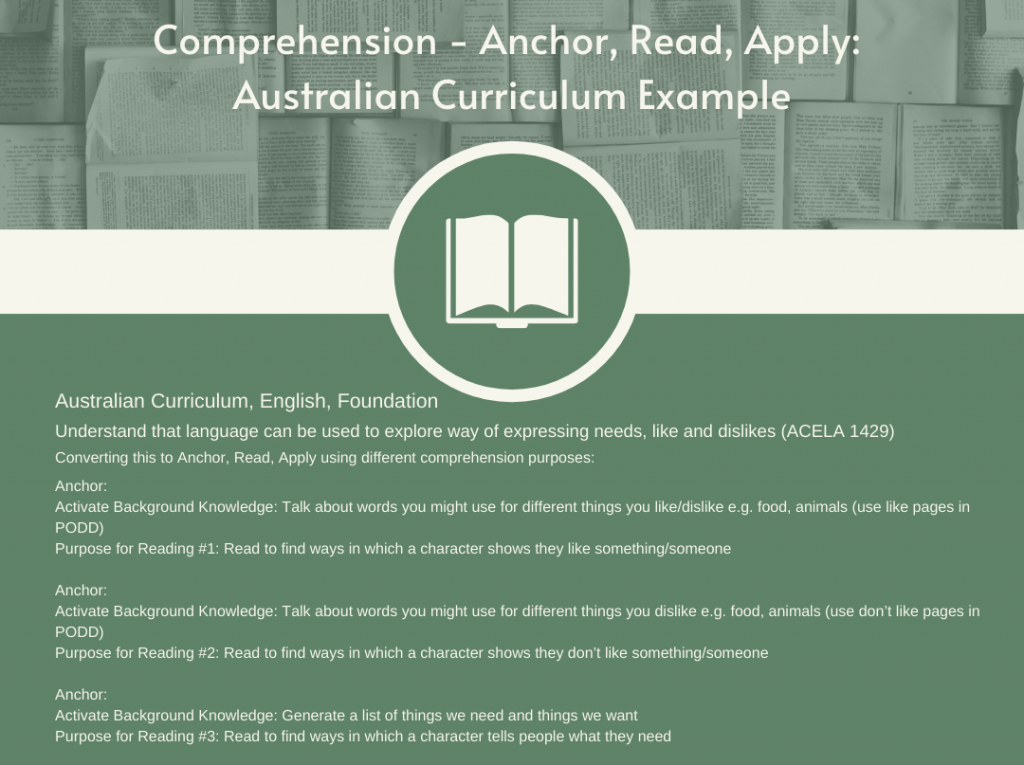Comprehension Instruction
(also called Guided Reading or Anchor, Read, Apply)
Reading with comprehension is the ultimate goal of all reading instruction. The aim of comprehension instruction is to give each student strategies that teach them how to extract information independently from text.
When I was at school, I was taught comprehension in a very ‘unfunctional’ way – but which was common practice at the time. I was given a passage to read and then I was asked multiple questions about it. There are many problems with this sort of comprehension work – but the biggest problem is that it doesn’t teach us the skills that we need to read with comprehension in the real world. As an adult I have NEVER said to myself “Hmmm – I’m going to read this article and then ask myself 10 random questions about it.”
In real life, comprehension is about reading for a purpose. I might say to myself “what train do I need to catch to get to Adelaide for 10am?” or I might ask “what should I do when I visit Rockhampton?”. I then search for, find and read the information I need – and extract that information. And – these are the skills we need to teach our students to read with comprehension in real life.
Three-Part Comprehension Instruction
To teach comprehension, we use three part comprehension instruction – Erickson & Koppenhaver (2020) call this Anchor, Read, Apply.
Anchor
The Anchor sets the scene – and anchors the whole task. Our ultimate aim is for a student to learn to set their own anchor but in the beginning we need to do this as part of teaching them what to do.
The Anchor has two parts:
- Discussing any background knowledge the student needs to understand the purpose or to comprehend the book
- Setting the purpose for reading ie the information we want the student to extract
Read
Student reads the book
Apply
Now the student applies their comprehension skills to the task and discusses the anchor, using their world knowledge and text knowledge.
And then there might be some follow up tasks – such as further research, or writing about the information they learned.
For early conventional students, we should have a focus on simple overall comprehension purposes for texts e.g. describe the characters, describe the setting, suggest a title, etc. Your local curriculum should give you guidelines about the sorts of information that students are expected to be able to independently extract. In Australia, you would use Australian Curriculum Foundation as your guide for these early comprehension purposes. Students will possibly need a lot of repetition to learn how to extract this information – and our job is to teach them how through our comprehension instruction.
As a student progresses, the comprehension purposes get more challenging – and, once again, we should be able to align these with our curriculum.

Extra tips:
- When reading a text with a focus on comprehension we would read it through without stopping to discuss it in any way. If you need to stop to explain it then the text is probably too difficult.
- By the time a student is at a grade 1 reading level we want them doing comprehension with books they have read. But at beginning of comprehension instruction the teacher can read the majority of the text at the beginning of the week and the students start joining in as the week progresses.
- It’s really important that this block involves the students’ reading the text and extracting the information, even if you have to progress to them reading the text through the week.
- We also need to make sure we activate any background knowledge that is needed to understand the text before reading the book e.g. explaining what a mammal is before reading a text about mammals. You don’t want to interrupt the reading with these explanations as it takes the emphasis away from comprehension.
Blog posts from Jane Farrall Consulting Related to Comprehension Instruction
- Reading Comprehension Instruction – and don’t forget the reading (Part 1)
- Reading Comprehension Instruction – and don’t forget the reading (Part 2)
Comprehension Resources to download:
- Contained in the blog post above
Other Resources
- Dynamic Learning Maps (DLM) self-directed learning module on Teaching Text Comprehension: Anchor Read Apply
- Dynamic Learning Maps (DLM) self-directed learning module on Generating Purposes for Reading
- Dynamic Learning Maps (DLM) self-directed learning module on Directed Reading-Thinking Activity (DR-TA) and Other Text Comprehension Approaches

